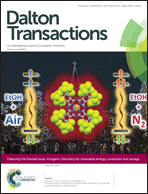The origin of the n-type behavior in rare earth borocarbide Y1−xB28.5C4
Abstract
Synthesis conditions, morphology, and thermoelectric properties of Y1−xB28.5C4 were investigated. Y1−xB28.5C4 is the compound with the lowest metal content in a series of homologous rare earth borocarbonitrides, which have been attracting interest as high temperature thermoelectric materials because they can embody the long-awaited counterpart to boron carbide, one of the few thermoelectric materials with a history of commercialization. It was revealed that the presence of boron carbide inclusions was the origin of the p-type behavior previously observed for Y1−xB28.5C4 in contrast to Y1−xB15.5CN and Y1−xB22C2N. In comparison with that of previous small flux-grown single crystals, a metal-poor composition of YB40C6 (Y0.71B28.5C4) in the synthesis successfully yielded sintered bulk Y1−xB28.5C4 samples apparently free of boron carbide inclusions. “Pure” Y1−xB28.5C4 was found to exhibit the same attractive n-type behavior as the other rare earth borocarbonitrides even though it is the most metal-poor compound among the series. Calculations of the electronic structure were carried out for Y1−xB28.5C4 as a representative of the series of homologous compounds and reveal a pseudo gap-like electronic density of states near the Fermi level mainly originating from the covalent borocarbonitride network.

- This article is part of the themed collection: Inorganic Chemistry for Renewable Energy Conversion and Storage

 Please wait while we load your content...
Please wait while we load your content...